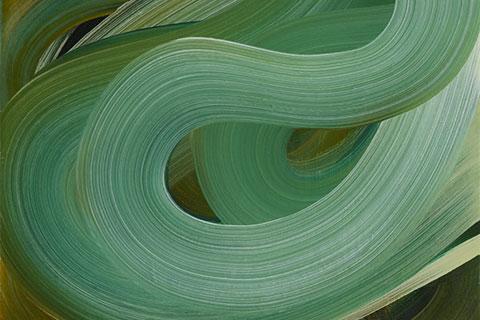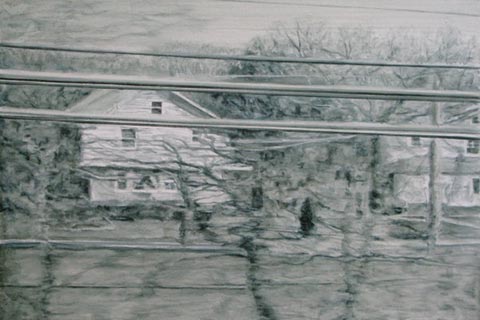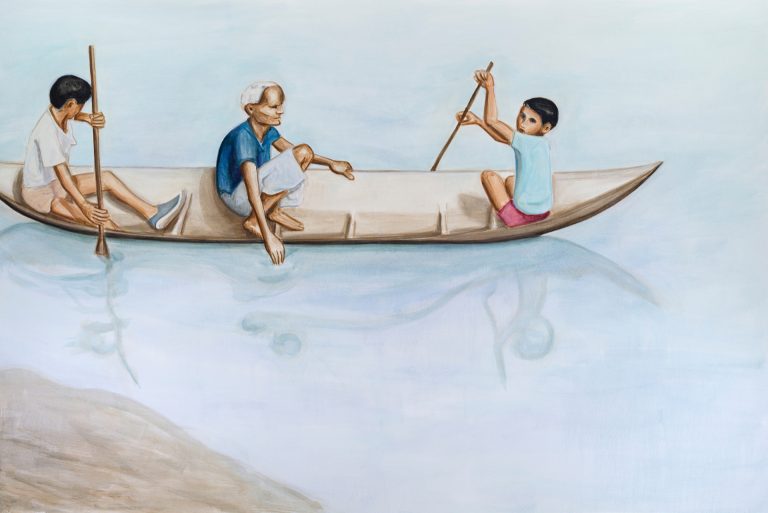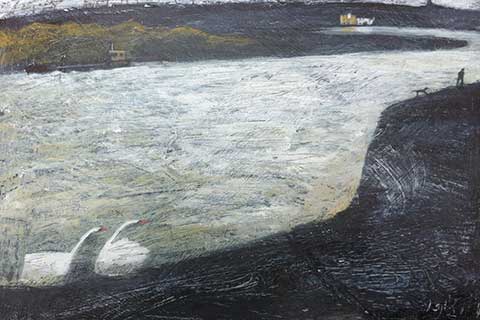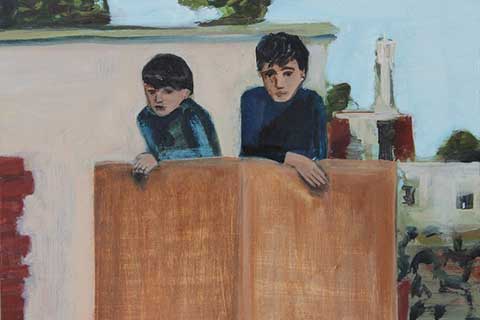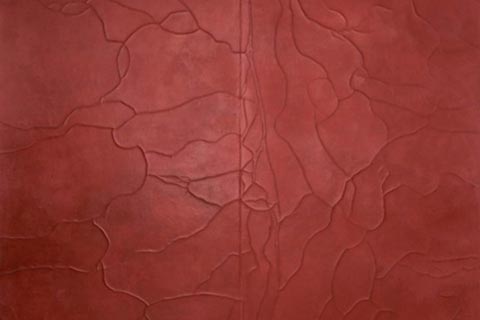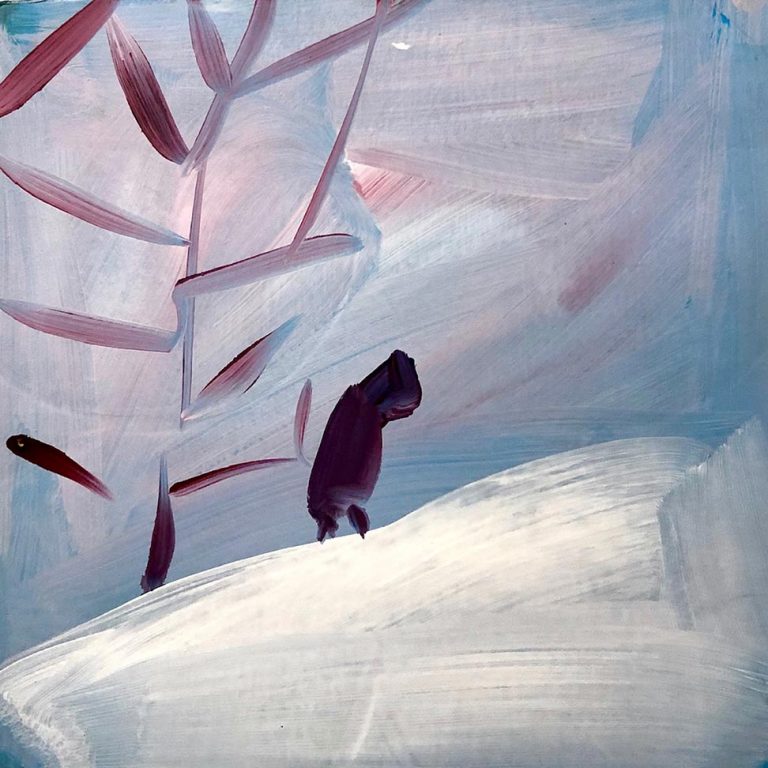Amanda Ansell in conversation with Barbara Howey
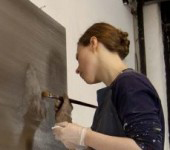
Barbara Howey: What are you working on at the moment?
Amanda Ansell: I’m working on a series of paintings that explore the relationship I have with landscape. I have two ways of working which run side by side; first of all, a series which I have been working on since 2012 which I titled ‘Willow Lands’.
These present close up willow, hanging like a curtain over an abstract background. I started these when a previous body of work, the ‘foam bubble islands’ had come to a close. I was first interested in the way the light shone through the ‘curtain’ and how these forms became abstracted to me, so there is a mix of dabs of paint, pastel colours, silvery backs of leaves. Some of the works get painted over; I lay washes over the top to push the image in to the background, adding another formation over the top to mingle with what now lies beneath. Besides these works I have a few paintings which started off as spontaneous doodles which are based on sensory moments, so for example, this could be the branches of a tree disrupting the surface flow of the water.
BH: It is interesting that you describe your development as a double process. That is the laying down of coloured grounds and then applying the images onto these grounds, which you have sourced through photography and sketches, and then working on top of these layers obscuring or obliterating the images with gestural marks. Do you think this process might be one of the same in that you need an image to work against so that you can make these gestural, flowing, rhythmic responses?
AA: For me this is my process of working. I have arrived at this process following a long period of development and finding my way with this new series of work. So I start with something that is depicted and then I strip this back. I feel that the image is something to detach myself from, to go beyond. I‘m having a dialogue with my process so I have the known, which is the photographed, the drawn, the perceived and then I have the attraction of what I don’t know, which is the process of painting over the top and my development of this. The gestural is a link to the psychological; to me, then there is this reaction to surface and something more tangible, the return to the real and the elements, so there is a metamorphosis of the two elements.
BH: There is calmness here in this more imagistic painting and a turbulence in this other more abstracted painting. The abstracted one seems to demonstrate the kind of language which is becoming more dominant in the later paintings, that is a more gestural, abstracted language. The depicted is just about there, which enriches the surface and gives a sense of space instead of a more two dimensional flatness evident in some of the earlier paintings.
AA: For me it is important that I have this going on in the painting to give it a kind of frailness.
BH: Yes, you can just about see the underpainted willow branches. You know they are there. This painting is a little bit like the surface of ice; I think that’s because of the opalescence of the gestural over-painting and the dark spatial depths. Ice is quite risky, fragile and perilous. What do you think it is about ice and water that interests you? Is it because they are calming, comforting, unnerving? There are so many qualities to water; it is necessary to life, it is beautiful, it is dangerous!
AA: Water is all of those things. It is life giving, life supporting, it can take away life so easily; it is the origins of life. For me it goes back to my early interest in the depiction of the female body in paintings; I started to research depictions of women bathing. This led on to the ‘Immersion Abstracts’ which I made at the Slade and which considered feelings of the body being immersed in water. Again there was this underbelly of something being not quite right; the paintings spoke of the body under water, foam touching the body, but some of the surfaces were a cool, light blue and there was a hint that perhaps the body was lifeless. Water is really significant because I grew up by the river, I used to swim in the river and now I have a studio overlooking the river. I can’t get away from it.
BH: I am interested in the process of layering – ‘laying down surfaces’, ‘adding to’, and ‘painting over’. You talk of what ‘lies beneath’, ‘surface’, and ‘background’. A sense of depth like the water that is so much part of your interests. What do you think this means in terms of your work? What idea of depth are you trying to convey?
AA: Surface is something which I have always been interested in and it can be many things. It can be shiny and deceptive and what lies underneath can be turmoil or something that is unknown and then there’s surfacing where things can be brewing up or rising from underneath and coming to touch. There’s also the feeling that what is on top is of now and immediate and what is below is what has gone, or perhaps the origin of what is now.
BH: You have previously mentioned the term Romanticism in relation to your interest in landscape as a response to the technological and digital preoccupations of our time. So in what terms do you think we can talk about Romanticism now because the word has changed so much since its origins in the 18th Century? There are so many things about the contemporary world that are abhorrent or antagonistic to the notion of “pristine wilderness”; our landscape is under pressure in all sorts of ways, from farming technologies, global warming to building projects etc… So where does that leave us as artists in terms of the Romantic tradition? How can we commune with nature when it is under such stress?
AA: It doesn’t help that people are obsessed with looking at pristine and charming images of idyllic landscape. For example, people put an image tag into their search engine, perhaps you put in ‘Constable Country’, you get a beautiful image, photographic images, someone’s holiday snaps, and you’re automatically transported there and that is not the reality of the place. It’s also the fact that if these distinguished places are not bought up by the wealthy, they become preserved, they have a cordon around them and then they aren’t those special, off the map places anymore. I don’t think having landscape paintings that are beautiful is sufficient. This isn’t enough for people to wake up and see that a particular place is worth protecting. For contemporary landscape painting, if it just becomes a depiction, it will only say this is the place, where do you belong, what is your position, do you know this place? Whereas for me, paintings that relate to landscape have to say something more and ask, how do we inhabit a place? What do you get from landscape, how does it feel and what is the significance of place? It’s not that image tag on Google; so the sensory thing is really important to me and then the fact that I’ve got the feeling that something is unsettled alongside this in my work – it is subtle, but that is my way of saying it. It is not obvious, but it is there.
BH: So what do you wish to convey through colour?
AA: What I’m trying to do is absorb the landscape around me into the act of painting, the stuff of paint and my process of overpainting. I do have rules when I start a body of work. So for this series I am using analogous colours from dark blue through to lime green-yellow, with some greys and browns thrown in. I selected these colours because they speak of the landscape outside my studio window and therefore have the potential to describe the sensory moments. Then all those other formal things; I am free to practice without thinking ‘now what colour should I use next’?
BH: I think it is quite important for artists to have their own set of rules otherwise we can become distracted and lose focus. In terms of your use of gestural marks do you have a system of procedures that you use? They seem quite organised gestures, quite poised in their relationship to one another. One overlaying gesture is reliant on the gestural mark beneath, that is, you respond to what is underneath; it doesn’t appear to be a random procedure?
AA: The ones underneath are quite random and they build up to the fixed formation on top. The composition is linked to the quick doodles I make. I know within a little what kind of form I’m going to paint over the top, so I think about that when I begin the layering. I almost practice what that is going to look like. But the layers also become random around these practice runs.
BH: So the ones underneath are a rehearsal you mean?
AA: They can be.
BH: But how do you determine that top layer?
AA: It is linked to the drawings and its final placement is dependent on the under-painting. So seductive areas like the viridian green here which meets with what I call my meadow green, I didn’t want to cover that up, so I knew I had to bring the gesture layer across here to preserve and enhance this area.
BH: So do you think you might be going on to making more large paintings?
AA: Yes and I’m also thinking of going portrait as I think a new format will take these works in a different direction and pose new possibilities for the work.



